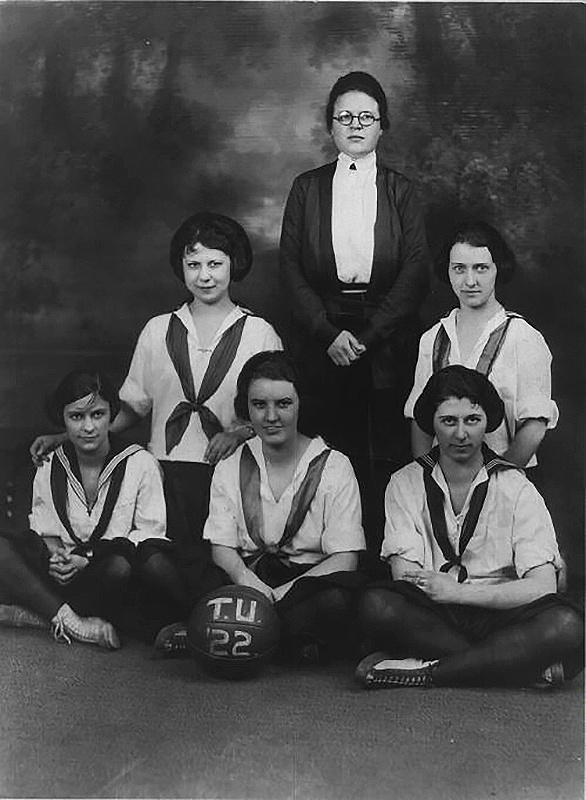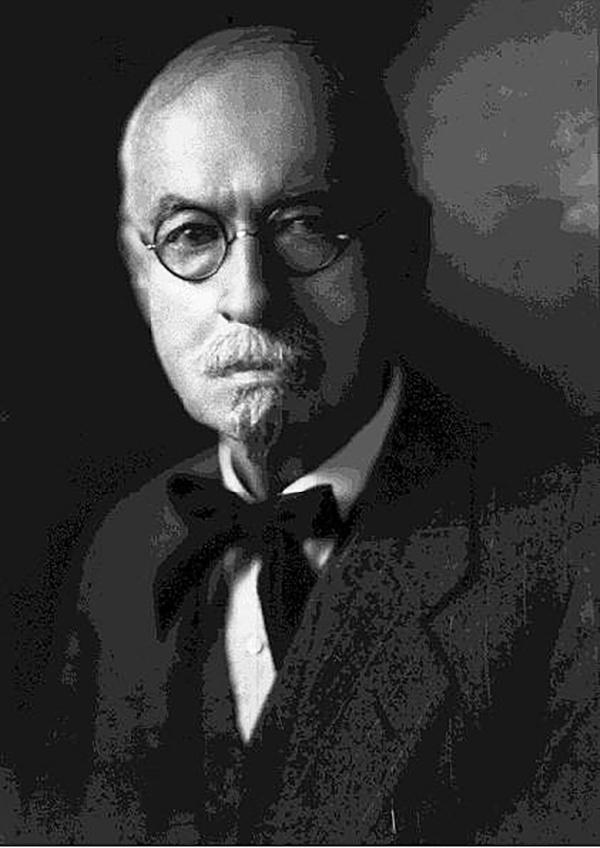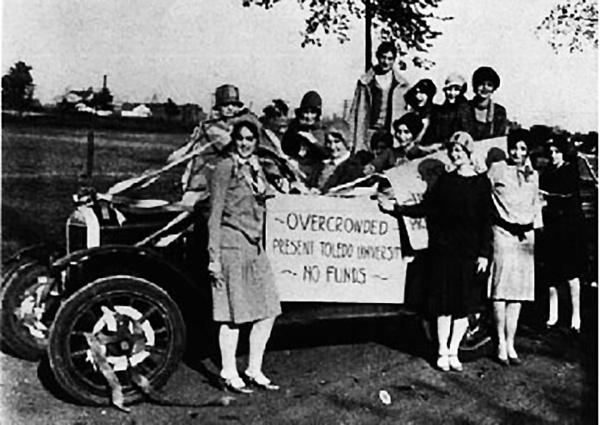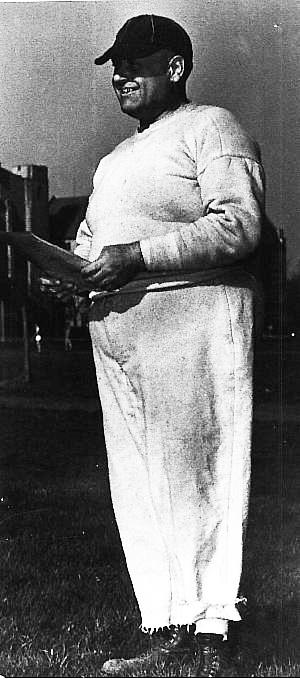Chapter 2. Finding a Permanent Home, 1920s-1930s
University Building on the Scott land on Nebraska Avenue in the 1920s. This building, partially constructed during World War I but never finished, was completed in 1922 as a classroom building for The University of Toledo. It was located on the Scott land at Nebraska Avenue. The university outgrew this building in less than ten years. By the 1920s, Toledo University was a growing institution, limited only by the buildings that housed it. Classes were held in the 11th and Illinois building and in the Toledo Medical College building at Cherry and Page. But with enrollments of 1500, not all students could fit into the auditorium; classrooms were crowded; and the library had to be used for classes and social events. New facilities were needed.
The first women's basketball team, 1922.
The buildings selected were the yet-unfinished automobile mechanics training facility and dormitory that had been constructed for the war effort on the original Scott land on Nebraska Avenue. With the U.S. role in the war so brief, the auto mechanics building was never completed and lacked floors, heating, and plumbing. City Council agreed in 1921 to spend $50,000 to complete that building as well as renovate the Students Army Training Corps dormitory located next door to it. While twice the size of the Illinois Street building, this location was less than ideal. It was hard to get to, was located in an industrial area, and looked like the factory it was intended to be. When renovations were completed, the university moved into the buildings in 1922, although classes continued to be held at the downtown buildings. The larger building was named the Science Building, and the dormitory was named the Gymnasium.
The Students Army Training Corps dormitory building, also located on the Scott land, was renovated as the Gymnasium in 1922.
As further evidence that the university was maturing, student participation in extracurricular activities increased. Student Council was created in 1919 as the governing body of the student population. Also that year, students Samuel Steinback and Leo Steinem started a student newspaper called The Universi-Teaser, which they sold for five cents. The newspaper staff also initiated a yearbook, called The Blockhouse, which was published in 1922. Greek organizations proliferated on college campuses in the 1910s, and their growth at UT led to the creation of the Pan-Hellenic Council in 1920 to oversee the groups. Deans of men and women were also appointed to assist with these student organizations.
Members of the Kappa Pi Epsilon sorority, 1922.
In 1915, the students had petitioned the Board of Directors for an intercollegiate athletic program. Football started in 1917, although the first game was a 145 to 0 loss to the University of Detroit. The basketball team fared better, losing only two games in 1919. The sports program progressed to the point that O. Garfield Jones, a professor of political science, was appointed the first part-time director of athletics. The sports teams received their nickname, the Rockets, in 1923 from local newspaper writers who thought the name reflected the teams’ style on the playing field.
The University of Toledo's fight song, "Fight for Our Dear OU:! T. U.," written by C.J. Dyer in 1922
In 1921, the university itself got a new name. President Stowe wanted a name that clarified the relationship between the university and the city in order to help the institution gain accreditation by the North Central Association. The city agreed to change the name to the University of the City of Toledo, which was shortened to the University of Toledo in 1941.
Dr. Stowe made an important improvement to the institution in 1917 when he created a real library and appointed a librarian. Prior to that time, the university had been using the city library. Despite this and other efforts to improve the institution and create a mature university, President Stowe began to have disagreements with the faculty and students. He resigned his position in 1925. Hard feelings remained between the Board and several faculty members who had disliked Dr. Stowe, and it was left to the new president, John W. Dowd, to mend fences.
John W. Dowd, president from 1925-1926.
President Dowd, who was 78 years old when appointed, served as president for only 14 months before he died. The next president, Ernest Ashton Smith, had an even shorter tenure, serving less than two months in 1927 when he died of a heart attack. During the interim periods between presidents, Dr. Lee MacKinnon served as acting chief administrator.
Lee W. MacKinnon, who served as chief executive during two interim periods following the deaths of John Dowd and Ernest A. Smith, 1925-1928.
The limitations of the Nebraska campus soon became evident. Despite being twice the size of the Illinois building, it was not big enough. An enrollment increase of 32 percent in one year made the situation critical. The space problem was exacerbated when a female student returning from classes at the Illinois building was beaten to death, and it became clear that this downtown neighborhood was too dangerous. The building located there would have to be closed. In November 1926, City Council appointed a subcommittee to consider a new site for the university.
Students participated in the campaign to gain passage of the bond levy for a new university campus in 1928.
President Henry J. Doermann at the groundbreaking for the new University of Toledo campus on Bancroft Street, 1929.
One of the circulars distributed to Toledo taxpayers to win support for the bond levy. It stressed that a new university would cost the average taxpayer less than $1 in new taxes.
The prospects for a new, permanent home for the institution improved in 1928 when the Board selected a new president, Dr. Henry J. Doermann. His first activity upon arriving in Toledo from Puerto Rico, where he had been university chancellor, was to plan for a new campus. He hoped to pay for the new campus by selling the Illinois, Cherry and Page, and Scott Park buildings. But legal difficulties held up the sale, and the city decided instead to place a bond levy before the voters to raise between $2.5 and $3 million. An all-out campaign orchestrated by O. Garfield Jones with the help of nearly all students and faculty led to the levy’s passage by 10,000 votes. The taxpayers’ approval came less than a year before October 29, 1929—Black Monday—and the start of the worst economic depression of modern times. A levy campaign in November of that year might not have been successful, and the university’s future would have been much bleaker.
With the money appropriated, the city began the search for a site for the new campus. Ottawa Park and Detweiler Park were among the 34 proposed locations. One attractive site was the Rufus Wright farm on West Bancroft. At a public hearing to consider the matter, Albert Macomber, then age 92, rose to speak. Rather than criticize the plans for a new campus, however, Macomber surprised all by supporting the move and suggesting that the Wright farm was the best site. An outside consultant agreed because it was centrally located, easily accessible, and located in a pleasant residential neighborhood. The 80 acres were purchased for $275,000.
The cornerstone for University Hall was put in place at a ceremony during commencement on June 12, 1930. President Henry Doermann spoke at the event.
Progress on the construction of University Hall in 1930 is shown in these photographs from the Henry J. Spieker Company, the contractor for the project.
The local architectural firm Mills, Rhines, Bellman, and Nordhoff was selected to design a classroom building and a multipurpose building for the site. Dr. Doermann wanted the buildings to reflect the best design elements of the old universities of Europe because he felt such architecture would provide an atmosphere to inspire students. A Collegiate Gothic design with a central tower and two enclosed courtyards was chosen for the classroom building, despite the objections of many Toledoans who felt the design was too extravagant. The Henry J. Spieker Company received the construction contract.
The cornerstone-laying ceremony coincided with commencement in 1930. It took 400 men eleven months to complete University Hall and the Field House. When the buildings were finished, President Doermann held a five-day open house in February 1931 for the taxpayers of the city, and 60,000 came to tour the new campus.
Some 400 men worked eleven months on the construction of University Hall and the Field House.
The theater in University Hall as it looked when completed in 1931. It was named in honor of President Henry Doermann following his sudden and unexpected death at the age of 42 in 1932.
The new campus was about all the citizens of Toledo had to cheer about in 1931. Toledo was hit hard by the depression, with a larger percentage of its population in bread lines than any other city in the nation. City workers took a ten percent pay cut, and the faculty voted unanimously to join them. This would be the first of four such cuts, not to mention several months when faculty were not paid at all, or were paid in “scrip.” Tuition was raised slightly for students taking more than 12 hours, up to $2 per credit hour.
Despite these difficulties and a career cut short by his untimely death, President Doermann realized some successes during his tenure as president. He capitalized on the tie between Toledo, Ohio, and Toledo, Spain, by forming a sister city relationship between the two cities. To reflect this relationship, the new university seal had the words “Guide to the Present, Moulder of the Future” written on it in old Spanish, rather than the more traditional Latin. In addition to planning the new campus and presiding over an institution during an economic depression, Dr. Doermann found time to direct a theatrical production of Hamlet in the new university theater in 1931. When he died suddenly in 1932, the theater was named in his honor.
May Day celebrations were an important student event. Pictured here is May Day,1930 .
Following an interim period presided over by Lee MacKinnon, the Board appointed Philip C. Nash as president in 1933. Dr. Nash had been dean of Antioch College and executive director of the League of Nations Association, a group that supported U.S. participation in the League. World affairs remained an interest throughout his life.
While enrollments remained stable at UT during most years of the Depression, due primarily to students from wealthier Toledo families who were forced to remain at home rather than go to Eastern colleges, the university’s financial situation was dire. President Nash instituted drastic measures to cut costs, including eliminating faculty phones, canceling the university catalog, and prohibiting faculty travel. The Board appropriated $3500 for special scholarships to help poor students attend the university. Additional funds came from the federal government, allowing students to pay for tuition by working at on-campus jobs.
Construction of Scott, Tucker, and Libbey Halls began in 1934, and was another project funded by the federal government's New Deal programs
The government’s New Deal programs provided other opportunities for federal funding for the university. Three faculty and student housing units (Scott, Tucker, and Libbey halls) were constructed with a federal loan and grant in 1934. The Works Progress Administration granted a contract in 1936 to build an 8000-seat stadium that kept many Toledo men employed. Funds from the Public Works Administration financed MacKinnon Hall, a women’s dormitory, in 1938. Artists working for the Civil Works Administration painted the seals of the alma maters of UT faculty on the walls of the third floor of University Hall and murals of Toledo history on the walls of the library. Another grant from the Works Progress Administration paid for the demolition of the Toledo Medical College building at Cherry and Page.
A football stadium was constructed by workers employed by the Works Progress Administration in 1936. Most of the work was done with shovels and wheelbarrows.
A community effort began in 1936 to help the UT library. With the assistance of the Toledo Chapter of the American Association of University Women, the Friends of the University Library was created. The group was similar to one that Philip Nash had known at Harvard. Its efforts especially were needed after a survey by the North Central Association of Colleges and Secondary Schools revealed that Toledo’s library was inadequate. Among the group’s activities was soliciting the donation of books from Toledo residents for the library.
The university library on the fifth floor of University Hall as it looked following the completion of historical murals by artists with the CWA, ca. 1940. (Photograph by Edward O'Reilly.)
When the Depression decade came to a close, the University of Toledo not only had survived, but in many ways had prospered. Thanks to the foresight of President Henry Doermann and federal funds made possible through the agencies of Franklin Roosevelt’s New Deal, the university had a new campus. Enrollments remained stable, and those students who attended during the decade felt a special closeness wrought by difficult times. Despite several months when the payroll could not be met, President Nash managed to keep the university out of the red. But the next decade would bring many more challenges to Dr. Nash, the student population, and the university.
A friendly game of tug of war, 1939.
Football coach Clarence "Doc" Spears, 1939.
The University of Toledo baseball team with coach David Connelly, ca. 1939.
Aerial view of the new university campus, 1938
























